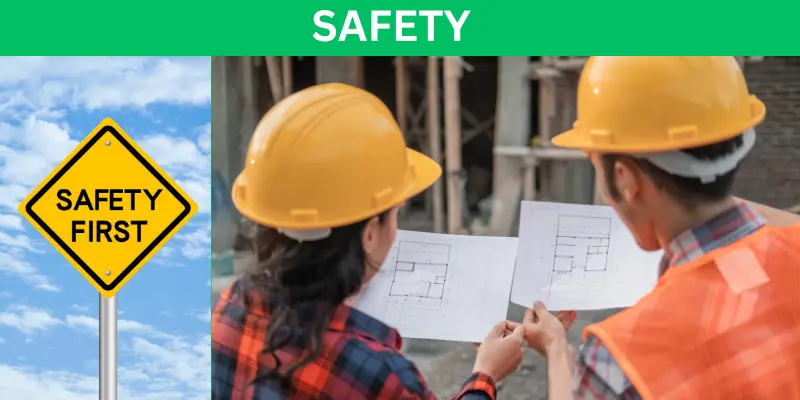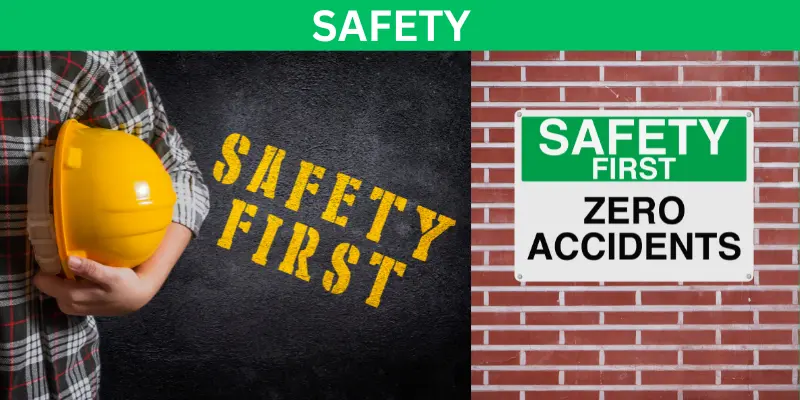What is safety: Essential Rules for Lives Saving
Updated: 15-Feb-2025
254
Safety is a fundamental aspect of life, ensuring the well-being of individuals, organizations, and communities. It involves taking precautionary measures to prevent accidents, injuries, or any harm in various settings, such as workplaces, homes, and public spaces. Understanding safety and implementing appropriate safety rules is essential for a secure and healthy environment.

1. Safety Definition
Safety is defined as being protected from or unlikely to cause danger, risk, or injury. It encompasses a wide range of practices, policies, and technologies designed to reduce hazards and enhance protection in different environments.
2. Safety Meaning
The meaning of safety extends beyond physical protection. It also includes psychological, environmental, and technological security measures that ensure a person’s well-being. Safety measures are implemented in industries, road transport, healthcare, and digital spaces to minimize risks.
3. Types of Safety
Here are some types of safeties.
1. General Safety
- Personal Safety—Protection of individuals from harm, injury, or danger.
- Public Safety—Measures taken to protect the general public from hazards.
- Community Safety—Ensuring safety within neighborhoods and local areas.
- Emergency Safety—Procedures for handling fires, earthquakes, floods, etc.
- Environmental Safety—Preventing harm to nature and human surroundings.
2. Workplace Safety
- Occupational Safety—Ensuring safe working conditions to prevent workplace accidents.
- Industrial Safety—Protection from hazards in manufacturing and heavy industries.
- Construction Safety—Preventing injuries at construction sites.
- Machine Safety—Proper handling of machines to avoid injuries.
- Office Safety—Ensuring a safe and ergonomic office environment.
- Factory Safety—Measures to prevent hazards in factories.
- Warehouse Safety—Avoiding accidents related to storage and heavy lifting.
- Lifting Safety—Proper lifting techniques to prevent back and muscle injuries.
- Ergonomic Safety—Workplace design to reduce strain and injuries.
- Welding Safety—Precautions for handling welding equipment.
3. Fire & Electrical Safety
- Fire Safety—Preventing fires and knowing how to respond to them.
- Electrical Safety—Safe handling of electrical systems to avoid shocks and fires.
- Explosion Safety—Preventing and responding to explosions in different environments.
- Gas Safety—Safe handling of gas appliances and cylinders.
- Burn Safety—Protection against burns from hot surfaces, chemicals, or fire.
4. Health & Medical Safety
- Food Safety—Proper food handling and storage to prevent contamination.
- Hygiene Safety—Ensuring cleanliness to prevent diseases.
- First Aid Safety—Knowledge of first aid procedures for injuries.
- Hospital Safety—Ensuring safety in medical facilities.
- Mental Health Safety—Reducing stress and ensuring emotional well-being.
- Radiation Safety—Protection from harmful radiation exposure.
- Biohazard Safety—Handling biological hazards safely.
- Pharmaceutical Safety—Safe use and storage of medicines.
- Patient Safety—Ensuring the well-being of patients in healthcare settings.
- Epidemic Safety—Preventing the spread of infectious diseases.
5. Home & Household Safety
- Home Safety—Preventing hazards within a household.
- Child Safety—Protecting children from home dangers.
- Elderly Safety—Ensuring a safe environment for senior citizens.
- Kitchen Safety—Preventing burns, cuts, and contamination in the kitchen.
- Bathroom Safety—Avoiding slips, falls, and water-related accidents.
- Appliance Safety—Proper use of household appliances.
- Poison Safety—Keeping toxic substances away from children and pets.
- Pet Safety—Ensuring a safe environment for pets.
- Water Safety—Preventing drowning and water-related accidents.
- Ladder Safety—Proper use of ladders to prevent falls.
6. Road & Transportation Safety
- Traffic Safety—Rules and precautions to prevent road accidents.
- Vehicle Safety—Using seatbelts, airbags, and vehicle maintenance.
- Pedestrian Safety—Safe walking practices near roads.
- Railway Safety—Preventing accidents at railway crossings and stations.
- Aviation Safety—Measures to ensure safe air travel.
- Maritime Safety—Protection against accidents in seas and oceans.
- Cycling Safety—Wearing helmets and following road rules.
- Motorcycle Safety—Wearing protective gear and safe riding practices.
- School Bus Safety—Ensuring safe travel for school children.
- Parking Lot Safety—Avoiding accidents in parking areas.
7. Cyber & Digital Safety
- Cybersecurity—Protection from online threats like hacking.
- Data Safety—Securing personal and business data.
- Social Media Safety—Protecting personal information online.
- Internet Safety—Avoiding scams, phishing, and cyberbullying.
- AI & Automation Safety—Ensuring safe use of artificial intelligence.
8. Sports & Recreation Safety
- Sports Safety—Using protective gear in sports activities.
- Gym Safety—Preventing injuries while exercising.
- Swimming Safety—Rules to prevent drowning and injuries.
- Adventure Safety—Precautions for hiking, rock climbing, etc.
- Playground Safety—Ensuring children play safely.
9. Weather & Natural Disaster Safety
- Flood Safety—Preparing for and responding to floods.
- Storm Safety—Protecting against hurricanes and tornadoes.
- Earthquake Safety—Knowing what to do before, during, and after an earthquake.
- Tsunami Safety—Awareness and evacuation strategies.
- Heatwave Safety—Preventing heat-related illnesses.
- Cold Weather Safety—Staying safe in extreme cold conditions.
10. Security & Crime Prevention
- Home Security—Protecting your home from break-ins.
- Workplace Security—Preventing theft and violence at work.
- School Safety—Protecting students and staff from threats.
- Travel Safety—Ensuring personal security while traveling.
- Self-Defense Safety—Learning ways to protect oneself.
- Terrorism Safety—Awareness and emergency procedures.
11. Agricultural & Farming Safety
- Farm Equipment Safety—Proper use of tractors and machinery.
- Livestock Safety—Handling animals safely.
- Pesticide Safety—Safe handling and storage of pesticides.
12. Energy & Utility Safety
- Nuclear Safety—Preventing nuclear hazards.
- Power Plant Safety—Ensuring safety in energy production.
- Water Supply Safety—Protecting clean water sources.
13. Transportation Industry Safety
- Truck Driving Safety—Safe long-distance driving practices.
- Shipping Safety—Precautions for cargo transportation.
14. Specialized Industry Safety
- Mining Safety—Preventing collapses and toxic exposure.
- Oil & Gas Safety—Preventing fires and leaks in petroleum industries.
- Laboratory Safety—Safe handling of chemicals and experiments.
- Fishing Safety—Ensuring safety while fishing at sea.
15. Miscellaneous Safety
- Festival Safety—Crowd control and emergency planning for events.
- Retail Safety—Preventing theft and workplace injuries in stores.
- Hotel Safety—Protecting guests from hazards.
- Wedding Safety—Ensuring smooth and safe events.
- Theater Safety—Fire and emergency safety in cinemas.
- Drone Safety—Safe flying of drones.
- Camping Safety—Preventing wildlife and fire hazards.
- Shooting Range Safety—Proper handling of firearms.
- Tattoo Safety—Ensuring hygiene in tattoo parlors.
- Bicycle Safety—Using helmets and lights.
- Theme Park Safety—Preventing ride-related accidents.
- Diving Safety—Preventing decompression sickness.
- Space Safety—Safety measures for astronauts.
- Amusement Park Safety—Ensuring safe rides and attractions.
- Scuba Diving Safety—Proper diving techniques.
- Astronomical Safety—Protection from space-related hazards.
4. What Are Safety Rules?
Safety rules are guidelines designed to prevent accidents and injuries. Some common safety rules include:
- Wearing protective gear in hazardous environments.
- Following traffic regulations to prevent road accidents.
- Keeping emergency exits clear.
- Using safety equipment properly.
- Practicing good hygiene to prevent contamination.
5. What is the meaning of safe?
The term safe refers to a state of being free from harm, danger, or risk. It is a condition in which precautions are taken to prevent injuries, damage, or loss.
6. Safety Full Form
The full form of SAFETY is “Stay Alert For Every Task You Do.” This acronym highlights the importance of being vigilant and cautious in daily life.
7. Safety Meaning in English
In English, safety refers to the condition of being secure from harm, accidents, or any danger. It is a fundamental aspect of daily life that ensures protection in various domains.
8. What is a safety factor?
The safety factor is a measure used to determine how much stronger a system, structure, or material is compared to the expected load or stress it will experience.
1. Definition of Safety Factor
A safety factor is the ratio of a system’s maximum strength to the actual applied load. It ensures that structures and systems operate within safe limits.
2. Safety Factors
Different industries use various safety factors based on the level of risk involved. Some commonly used safety factors include:
- Structural safety factors—Used in engineering and construction.
- Equipment safety factors—applied to machinery and tools.
- Material safety factors—Considered in the production of durable goods.
9. Safety Evaluation Report
A safety evaluation report (SER) is a document that assesses the safety performance of a system, structure, or process. It includes:
- Risk assessments
- Compliance with safety standards
- Incident analysis
- Recommendations for improvements
10. International Recommendation on Safety
Several international organizations set safety standards and recommendations, such as:
- International Organization for Standardization (ISO) – Safety management standards.
- Occupational Safety and Health Administration (OSHA)—Workplace safety regulations.

11. Most Relevant FAQs About Safety
1. What is safety in simple words?
Safety means taking precautions to prevent harm, accidents, or dangers in daily activities.
2. Why is safety important?
Safety is essential to protect lives, reduce injuries, and prevent property damage.
3. What is the best safety practice?
Following guidelines, using protective equipment, and staying alert are best practices for safety.
4. What are the five basic safety rules?
- Always be aware of your surroundings.
- Follow safety guidelines and regulations.
- Wear appropriate safety gear.
- Keep emergency contacts handy.
- Report hazards immediately.
5. What is an example of safety?
Wearing a seatbelt while driving is an example of road safety.
6. What is the difference between safety and security?
Safety protects against accidental risks, while security prevents intentional threats.
7. How do companies ensure workplace safety?
Companies enforce safety policies, provide training, and conduct regular inspections.
8. What does PPE mean in safety?
PPE stands for Personal Protective Equipment, such as helmets, gloves, and masks.
9. What is the role of safety officers?
Safety officers ensure compliance with safety standards and conduct risk assessments.
10. How can individuals promote safety at home?
By using fire alarms, keeping emergency exits clear, and following hygiene practices.
12. Conclusion
Safety is a crucial aspect of life that ensures protection from hazards, risks, and accidents. By understanding its meaning, types, and implementation, individuals and organizations can create a safer environment. Whether at work, home, or public spaces, following safety rules and recommendations is essential for well-being and security. Implementing safety measures not only protects lives but also promotes efficiency and confidence in everyday activities.
Please Write Your Comments